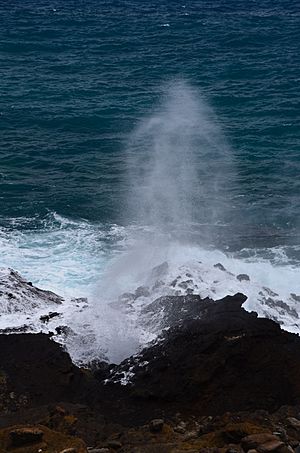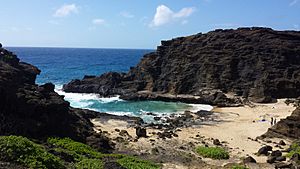Hālona Blowhole facts for kids
Hālona Blowhole is a super cool natural wonder on the island of Oahu, Hawaii. It's located near Hanauma Bay at Hālona Point, right by the big Pacific Ocean. The name hālona means "lookout" in the Hawaiian language, which makes sense because it's a great spot to look out at the ocean!
Contents
What is the Hālona Blowhole?
Imagine a giant water geyser made by the ocean! On windy days, especially when the tide is high, big waves crash against the shore. The water rushes into a special rock formation that acts like a cave. Then, a powerful blast of sea spray shoots high into the air, sometimes as tall as a three-story building! This can reach up to thirty feet high.
Hālona Point is a very popular spot for visitors. People come to see the amazing scenery and enjoy the beach at the nearby cove. During winter, it's also a fantastic place to spot humpback whales or Honu (Hawaiian Green Sea Turtles) swimming in the ocean. The blowhole is one of the most famous natural blowholes in all of Hawaii.
How the Blowhole Was Formed
Discovering the Blowhole's History
The Hālona Blowhole was created thousands of years ago. This happened during a time when Oahu had a lot of volcanic activity. Hot lava from Koko Crater flowed all the way into the ocean. As the lava cooled, it formed long, narrow tunnels called lava tubes. These tubes extend deep into the ocean.
There's also a narrow crack, or rift, at the bottom of the cliff. This crack formed when a huge piece of rock broke away from the land. When waves crash into these lava tubes and the rift, the water gets squeezed. This pressure then forces the sea spray out of the narrow opening, creating the blowhole effect!
Exploring Hālona Cove
What to See at the Cove
Right next to the Hālona Blowhole is a small sandy spot called Hālona Cove. Locals sometimes call it "Cockroach Cove." It's a favorite place for both tourists and people who live nearby to go swimming. But remember, it's only safe to swim here when the ocean is calm and the waves are not too big.
In a large, wedge-shaped area next to the cove, you can find a reef covered with a special type of soft coral called Sinularia Leather Coral. This reef is home to many different kinds of sea creatures. You might see echinoderms (like sea urchins), colorful slugs, other types of corals, and even eels hiding among the rocks. It's like a natural aquarium!
Staying Safe at Hālona Point
Important Safety Tips
It's important to know that the ocean currents below Hālona Point can be very strong. The area is close to the Ka Iwi channel, which is known for powerful currents. Always be careful when visiting and follow any safety signs. It's best to stay on marked paths and enjoy the views from a safe distance, especially near the blowhole and the water's edge.
Images for kids




